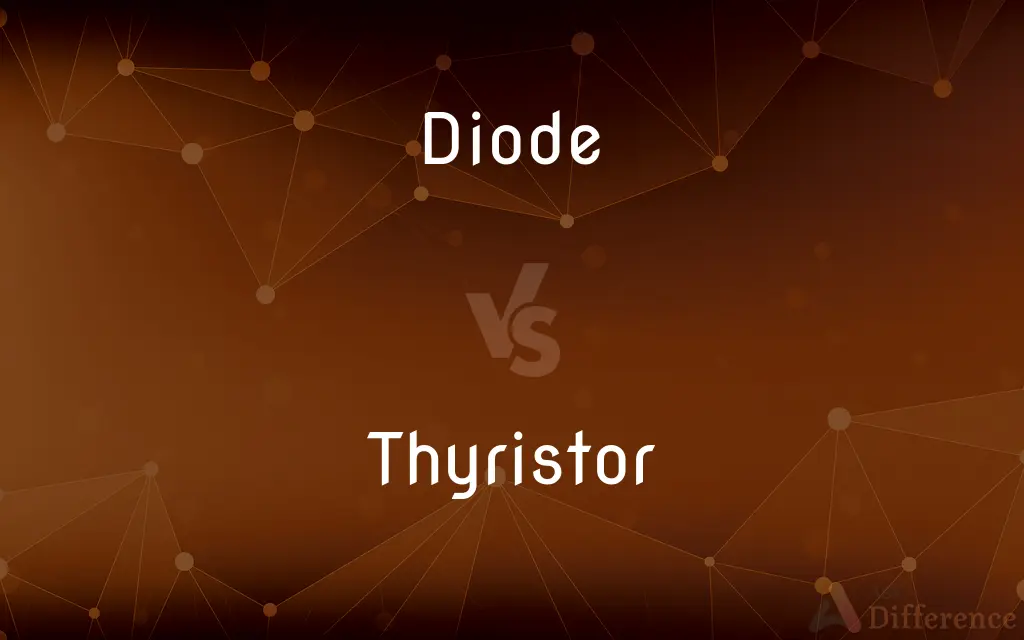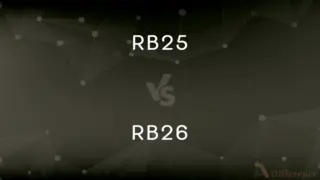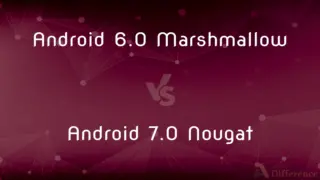Diode vs. Thyristor — What's the Difference?
By Tayyaba Rehman & Fiza Rafique — Published on February 19, 2024
A diode is a semiconductor device that allows current to flow in one direction only, while a thyristor is a four-layered semiconductor device that acts as a switch, conducting when its gate receives a current pulse.

Difference Between Diode and Thyristor
Table of Contents
ADVERTISEMENT
Key Differences
Diodes and thyristors are both crucial components in the field of electronics, each serving distinct purposes based on their unique properties. A diode, fundamentally, is a two-terminal device, typically made of semiconductor material, that allows current to flow through it in one direction only. This unidirectional flow makes diodes essential for tasks like rectification in power supplies, where alternating current (AC) is converted to direct current (DC). Thyristors, on the other hand, are more complex, consisting of four semiconductor layers that form a three-terminal device, including an anode, cathode, and gate.
A diode is always in either conducting or non-conducting state depending on the polarity of the voltage applied across its terminals, while a thyristor requires a gate signal to begin conduction. Once triggered, a thyristor remains conducting until the current through it drops below a certain threshold, making it useful for applications where control over the current flow is needed, such as in variable-speed motor drives, dimming circuits for lights, and in power conversion.
Diodes are known for their simplicity and reliability, with variants like Zener diodes and Schottky diodes providing specialized functions such as voltage regulation and fast switching, respectively. Thyristors, such as Silicon Controlled Rectifiers (SCRs) and TRIACs, offer more control and are capable of handling higher power levels, making them suited for more demanding applications that require the ability to switch on and off large currents or voltages.
The choice between using a diode or a thyristor in a circuit depends on the specific requirements of the application. Diodes are preferred in circuits that need straightforward, uncontrolled rectification or protection. In contrast, thyristors are chosen for their ability to control and switch high power loads, with the added complexity of requiring a gate signal for operation.
Both diodes and thyristors are fundamental to electronic circuits, serving to control the flow of current, their operational characteristics and applications differ significantly. Diodes provide simple, reliable unidirectional current flow, useful for protection and rectification, whereas thyristors offer controlled, switchable conduction suitable for power control applications.
ADVERTISEMENT
Comparison Chart
Basic Structure
Two-terminal (anode and cathode)
Three-terminal (anode, cathode, and gate)
Function
Allows current flow in one direction only
Acts as a switch, controlling current flow
Triggering
Conducts when forward-biased
Conducts when gate receives a current pulse
Applications
Rectification, protection, signal modulation
Power control, motor control, light dimming
Complexity
Simple, no external control required
More complex, requires gate signal for operation
Compare with Definitions
Diode
A component that allows current to flow in only one direction.
I used a diode to prevent battery discharge in the wrong direction.
Thyristor
A semiconductor device used to control power flow.
The motor's speed is controlled by a thyristor in the circuit.
Diode
Can be used for signal modulation in communication systems.
Diodes in the mixer circuit modulate the radio frequency signal.
Thyristor
Requires a gate pulse to start conducting.
We triggered the thyristor using a short pulse to the gate.
Diode
Provides overvoltage protection in electronic circuits.
A Zener diode protects the circuit from voltage spikes.
Thyristor
Remains conducting until the current falls below a certain level.
Once activated, the thyristor continued to conduct until we reduced the load.
Diode
Used in solar panels to prevent reverse current flow.
Bypass diodes in solar panels maximize the output by preventing shading issues.
Thyristor
Commonly used in AC power control applications.
Thyristors are ideal for dimming lights in an AC circuit.
Diode
Essential for converting AC to DC in power supplies.
The power supply's efficiency is ensured by the rectifier diodes.
Thyristor
Can handle high voltage and current levels.
For high-power applications, we prefer thyristors due to their robustness.
Diode
An electrical device, such as a semiconductor or electron tube, through which flow of current is generally restricted to one direction. Diodes are often used in or as rectifiers.
Thyristor
(electronics) A semiconductor diode having an extra "gate" terminal to switch it on.
Diode
A semiconductor that consists of a p-n junction
Common Curiosities
What is a thyristor?
A thyristor is a four-layered semiconductor device that acts as a switch, controlling the flow of electrical current.
How is a thyristor different from a diode in terms of structure?
A thyristor has three terminals (anode, cathode, and gate) and four layers of semiconductor material, while a diode has two terminals (anode and cathode) and typically two layers.
Where are thyristors most commonly used?
Thyristors are widely used in power control applications, such as in dimmers, motor speed controls, and voltage regulation.
Can diodes be used for power control like thyristors?
Diodes are not typically used for power control because they cannot be turned off by a gate signal like thyristors.
What are the common applications of diodes?
Diodes are commonly used in rectification, voltage regulation, protection circuits, and signal modulation.
What happens if a thyristor is not triggered?
If a thyristor is not triggered, it remains in the off state, not allowing current to flow through it.
What is a diode?
A diode is a semiconductor device that allows current to flow in only one direction.
Can a diode conduct in reverse bias?
Under normal conditions, a diode does not conduct in reverse bias, except in the case of breakdown (as in Zener diodes).
How is a thyristor turned on?
A thyristor is turned on by applying a current pulse to its gate terminal.
Can I replace a diode with a thyristor in a circuit?
Replacing a diode with a thyristor is not straightforward due to the thyristor's need for a gate signal and its different operational characteristics.
What determines the choice between using a diode or a thyristor in a circuit?
The choice depends on the application's need for unidirectional current flow (diode) or controlled switching (thyristor).
Can thyristors be used in DC circuits?
Yes, thyristors can be used in DC circuits, particularly for switching and controlling high-power devices.
Are diodes and thyristors affected by temperature?
Yes, the performance of both diodes and thyristors can be affected by temperature, impacting their conductivity and overall operation.
Do diodes and thyristors have polarity?
Yes, both diodes and thyristors have polarity; diodes have an anode and cathode, and thyristors also have a gate terminal in addition.
Are there different types of thyristors?
Yes, there are several types of thyristors, including Silicon Controlled Rectifiers (SCRs), TRIACs, and DIACs, each with unique characteristics.
Share Your Discovery

Previous Comparison
RB25 vs. RB26
Next Comparison
Android 6.0 Marshmallow vs. Android 7.0 NougatAuthor Spotlight
Written by
Tayyaba RehmanTayyaba Rehman is a distinguished writer, currently serving as a primary contributor to askdifference.com. As a researcher in semantics and etymology, Tayyaba's passion for the complexity of languages and their distinctions has found a perfect home on the platform. Tayyaba delves into the intricacies of language, distinguishing between commonly confused words and phrases, thereby providing clarity for readers worldwide.
Co-written by
Fiza RafiqueFiza Rafique is a skilled content writer at AskDifference.com, where she meticulously refines and enhances written pieces. Drawing from her vast editorial expertise, Fiza ensures clarity, accuracy, and precision in every article. Passionate about language, she continually seeks to elevate the quality of content for readers worldwide.














































